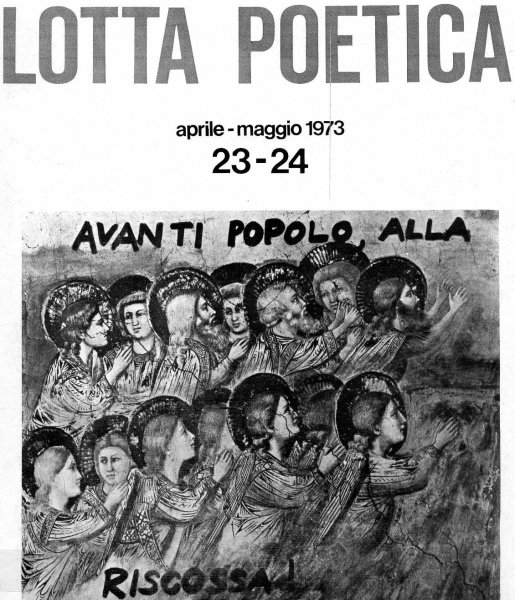An iconographic and text archive related to communication, technology and art.
☛ Lotta Poetica, “Poetical Licence” by Sarenco, nos. 23–24, Apr. – May 1973, p. 12 (PDF). Image retrieved from the Museo della Carale website. Alternatively, see Capti – Contemporary art archives periodicals texts illustrations as well as the Imago Mundi Collection [Updated 2025.06.15]
The information that follows can be helpful in understanding the context in which this image was produced and published. Additional references are provided at the end.
Sarenco (pseudonym of Isaia Mabellini) is an Italian critic and visual artist. In the 70s, as a member of the collective Gruppo 70, he actively participated in the development and diffusion of the artistic movement called “Visual Poetry” (Poesia Visiva). Among many other things, he was cofounder of the magazine Lotta Poetica (Poetic War or Poetic Struggle), along with Belgian artist and poet Paul de Vree. The first issue of the polemical magazine appeared in June 1971. From the beginning, the objective was to assign poetry in particular, and art in general, with a concrete political function, “bonding visual poetry with Marxism and political activism” (Images and Imagery, New York: Peter Lang, 2005, p. 81). In a text published in 1972 in the anthology Poesia e/o poesia, Sarenco wrote:
[W]hat we demand is the unity between politics and art, the unity of content and form, the unity of a political revolutionary content and artistic form as perfect as possible… our avant-garde “poetic” position cannot but be a fundamentaly avant-garde “political” position: the awareness of the absolute value of class struggle for the triumph of the dictatorship of the proletariat. (quoted in Ibid.: 86; original Italian version quoted in The New Avant-garde in Italy: Theoretical Debate and Poetic Practices by John Picchione, University of Toronto Press, 2004, p. 189)
For this reason, “Visual Poetry” (also sometimes labelled “concrete poetry”) often took aim at what was identified as “conceptual art”:
It is perhaps against this spectacularization of the artist as commercial rather than social figure that Sarenco, the Italian visual poet, critic, and publisher, launched a serial attack on conceptual art in his journal Lotta Poetica at the beginning of the seventies. In several articles printed between 1971 and 1972, all titled “Poesia visiva e conceptual art / un plagio ben organizzato [Visual Poetry and Conceptual Art / A Well-Organized Plagiarism],” he attacks language-based conceptual work produced by figures like Kosuth, Andre (in his poetry), and Richard Artschwager. Sarenco largely avoids examples of their work, however, instead opting to disqualify the entire conceptual art movement as derivative and socially corrupt. (“Concrete Poetry and Conceptual Art: A Misunderstanding” by Jamie Hilder, Contemporary Literature, Vol. 54, No. 3, Fall 2013, 608)
For more information about Sarenco and the “Visual Poetry” movement, one may consider the following references:
-
Above, I have quoted from an article by Jamie Hilder. The article is based on a PhD he did in 2010 at the English Department at the University of British Columbia. The complete thesis is available online at the time of writing: “Designed Words for a Designed World: The International Concrete Poetry Movement, 1955-1971”.
-
The text of a lecture delivered by Patrizio Peterlini at 2012 Symposium about Paul de Vree (1909-1982) is available at the author website. It covers part of the history of the magazine Lotta Poetica: “Paul De Vree in Italy: Lotta Poetica and Factotum Art”.
-
In November 1972, radiOM broadcasted a 44-mins radio program about “Sarenco and the Visual and Sound Poetry of Italy”. It is still possible to listen to the program online. A copy of the recording is also hosted at the Internet Archive. Here’s the description of the program:
During the 1970s in Italy, a group of visual poets stirred up quite a scene around Florence. The ring leader, a young poet who goes by the name of Sarenco issued a periodical called Lotta Poetica (Poetic War), a communist, anti-imperialist, anti-capitalist monthly devoted primarily to poetry with visual elements. Members of this Gruppo 70 as they came to be called included Eugenio Miccini, Luciano Ori, Lucia Marcucci, Giusi Coppini, Michele Perfetti and Lamberto Pignotti. Here is a report on their subversive activities, which eventually led the police to confiscate their printing presses and another avant-garde periodical, Flash Art to denounce their leader, Sarenco.
-
The University of Sidney produced a catalogue for its 2009 exhibition “Poesia Visiva. Italian Concrete & Visual Poetry of the 1960s & 1970s”. A PDF version of the catalogue is available online at the time of writing [archive].
-
The Haggerty Museum of Art produced a catalogue for its 2005 exhibition “Visual Poetry. Contemporary Art From Italy” (see Past exhibitions and publications). A PDF version of the catalogue is available online at the time of writing [archive].
-
BTA. Telematic Bulletin of Art: “Sarenco. Word, image, behaviour” by Giuseppe Carrubba, December 2, 2004, no. 382. This is a review of a 2004 exhibition by Sarenco, hosted at the Kore Arte Contemporanea, in Florence. It comes with a short bibliography (Italian titles), a list of significant previous exhibitions by Sarenco, and a short biography.
-
M HKA Ensembles has a short biography of Sarenco.
• • •

- By Philippe Theophanidis
- on
- ― Published in Art
- Tagged: activism, avant-garde, poetry, politics, praxis, Sarenco, struggle

